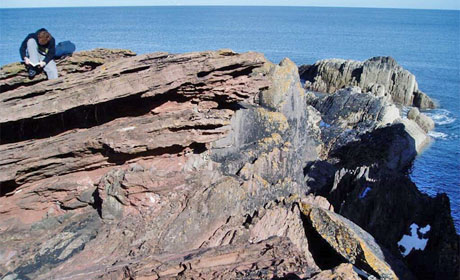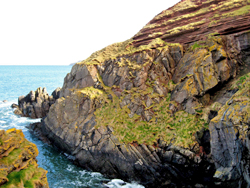Siccar Point
Berwickshire, Scotland

'Siccar Point, East Lothian. Maybe the most famous unconformity?'
From Johannes Miocic, @JohoMio
"Hutton's Unconformity at Siccar Point, Firth of Forth, the origin of the concept of "deep time""
From Alan Roberts on Facebook
'Hutton's unconformity! I couldn't really not post this, could I?'
From Daniel Hobley @Siccar_point
Accorded Site of Special Scientific Interest status in 1961, the Siccar Point unconformity (known as Hutton’s Unconformity) is an internationally famous place of geological pilgrimage. It is of great historical importance in the development of the science of geology and described as the most important geological location in the world.

In 1788, James Hutton first discovered Siccar Point, and understood its significance. It is by far the most spectacular of several unconformities that he discovered in Scotland, and very important in helping Hutton to explain his ideas about the processes of the Earth.
At Siccar Point, nearly vertical sedimentary rocks of Silurian age – greywacke sandstones and mudstones – are covered unconformably by a younger sequence of red sandstone and breccia.
Hutton used Siccar Point to demonstrate the cycle of deposition, folding, erosion and further deposition that the unconformity represents. He understood the implication of unconformities in the evidence that they provided for the enormity of geological time and the antiquity of planet Earth, in contrast to the biblical teaching of the creation of the Earth.
A casting of the Siccar Point unconformity is housed in the American Museum of Natural History in New York.
One of Hutton’s companions, John Playfair, wrote of Siccar Point:

“On landing at this point, we found that we actually trode on the primeval rock, which forms alternately the base and the summit of the present land. It is here a micaceous schistus, in beds nearly vertical, highly indurated, and stretching from south-east to north-west. The surface of this rock runs with a moderate ascent from the level of low-water, at which we landed, nearly to that of high-water, where the schistus has a thin covering of red horizontal sandstone laid over it; and this sandstone, at the distance of a few yards farther back, rises into a very high perpendicular cliff. Here, therefore, the immediate contact of the two rocks is not only visible, but is curiously dissected and laid open by the action of waves.”
“On us who saw these phenomenon for the first time the impression will not easily be forgotten…We felt necessarily carried back to a time when the schistus on which we stood was yet at the bottom of the sea, and when the sandstone before us was only beginning to be deposited, in the shape of sand or mud, from the waters of the supercontinent ocean… The mind seemed to grow giddy by looking so far back into the abyss of time; and whilst we listened with earnestness and admiration to the philosopher who was now unfolding to us the order and series of these wonderful events, we became sensible how much further reason may sometimes go than imagination may venture to follow.”
Watch Prof Iain Stewart's video about Siccar Point
Video: Prof Iain Stewart
Harry Whalley's Strange Cathedrals
Strange Cathedrals is an orchestral piece in 5 movements that are proportional to the length of the corresponding geological time span (in reverse order):
1) First Vertebrates (c 380ma)
2) Oxygen Rich (c580ma)
3) Atmosphere (c2300ma)
4) Photosynthesis (3200ma)
5) Heavy Bombardment (4000ma)
This orchestral piece was then slowed down (through a combination of analogue and digital methods). The intention is to listen to the piece during a geological walk from Cove to Siccar point.
Listen to Strange Cathedrals on SoundCloud
Dr. J Harry Whalley FLCM
Related Links
- The making of an angular unconformity: Hutton’s unconformity at Siccar Point (Blog post at Highly Allochthonous)
- Geowalks: Siccar Point
- The Geological Society of Glasgow page on Siccar Point
- The Geological Society of London on a proposal to construct a waste pipeline near Siccar Point
- ScottishGeology.com
- Harry Whalley's Strange Catherdrals
Images (top to bottom):
- Siccar Point © Daniel Hobley
- Siccar Point South-East Cliff © Dave Souza (Source Wikimedia Commons) Creative Commons Attribution-Share Alike 4.0 International
- 1852 Illustrations from A Manual of Elementary Geology, by Charles Lyell Frontispiece and Fig.83 (Source Project Gutenberg)

October 13 - 21
Theme: 'Earth Science in our lives'
